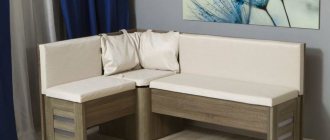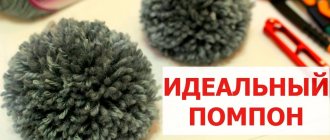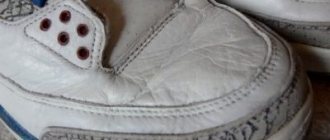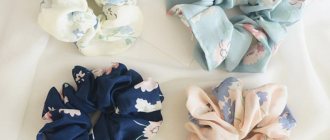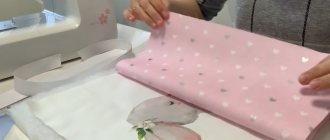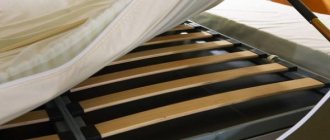What is furniture reupholstery?
Reupholstery is the replacement of upholstery and lining materials. Often, high-quality work results cannot be achieved without disassembling the furniture. The upholstery of many kitchen corners can only be updated by disassembling the structure into individual elements. It is easier to remove the old coating from them without causing damage to other parts. In most cases, repairing a kitchen corner is not limited to reupholstery, since you have to strengthen the frame of the sofa, cover it with varnish or paint, change fasteners, accessories, etc.
Tools you'll need
- Anti-stapler - for removing staples from furniture. You can use a regular knife.
- Scissors for cutting fabrics.
- Sewing machine.
- Measuring tape.
- Hammer.
- Wrenches for disassembling the frame.
- Furniture stapler for installing new upholstery.
- Ticks.
- Pencil.
This is a minimal and necessary set of tools, which you cannot do without in the process of repairing a sofa. If you want to make some unusual designs, you will most likely need more tools (and more complex ones). It all depends on the complexity of the reconstruction you have planned.
Reupholstery and restoration of the kitchen corner
For many people, purchasing a new kitchen corner always takes a backseat, as it is expensive and there are always more important and necessary things to buy.
In one or two days it is quite possible to update a worn-out soft corner and refresh the kitchen interior.
In such a situation, restoration and reupholstery of the kitchen corner becomes a good option. Of course, you can take the furniture to a specialized workshop or call a craftsman directly to your home, but you can also do this work yourself.
A comfortable soft sofa in the dining area pleases the eye and gives the entire kitchen a feeling of coziness.
Such furniture has a fairly simple design, so restoration can be done even by a person with no experience, who has never wondered how to reupholster a kitchen corner.
Advantages of DIY repairs
Restoration work on a kitchen corner, due to its simple design, is not difficult not only for an experienced, but even for a novice home craftsman. He will quickly master the intricacies of reupholstering furniture in the kitchen. But besides the pride in the work you’ve done yourself and the admiration of your family, do-it-yourself repairs have other advantages:
- significant savings in the family budget;
- consolidation of repair skills;
- ability to plan work time;
- choosing the upholstery material to your liking.
Today, the kitchen in many apartments has become the most lived-in and favorite place.
How to tighten it with your own hands?
To restore a kitchen corner yourself at home, you need to understand the sequence of actions of this process. It is worth considering the main stages of remodeling old furniture and its complete transformation.
- Removing old upholstery from a kitchen corner using a staple remover or a tool you have at home for removing furniture staples. It is better not to throw away the material; it will be useful for cutting new upholstery.
- Remove the old layer of foam rubber so that there are no residues. If the foam rubber was glued, then it will be possible to remove it completely only with the help of a knife.
- Cut out new upholstery using old samples. The new pattern must exactly match the one that was previously eliminated, otherwise replacing one with another will be problematic. It is best to mark the edges of a new product using chalk or a bar of soap so that the incorrectly made part can be easily erased. When cutting out a pattern, it is important to leave 5 cm on each side to make starts that will tuck during attachment to the furniture frame. It is recommended to buy material with a reserve so that there is enough of it during cutting. If there is anything left after creating the patterns, you can use the fabric for its intended purpose and update chairs or stools, and, if desired, make soft cushions for the future kitchen corner.
- The finished templates are sewn together using a sewing machine. It is worth making several seams to maximize the strength of the structure and prevent it from coming apart in the future.
- Repairing a kitchen corner also involves replacing the soft component, so it is necessary to lay new foam rubber and secure it. For fixation, you can use various glues: construction glue, from a gun or “Moment”. If there is no desire or need to attach the soft component to the frame, you can connect it to the upholstery, securing it with furniture nails or staples.
- The final touch will be putting new covers on the kitchen corner and checking their size. If something needs to be redone, there is still an opportunity for this. As soon as everything is in place, the most important stage begins, in which you should not rush - this is attaching new upholstery to old furniture. You can work using an industrial stapler, which quickly and securely fixes staples to the base of furniture. The staples should be spaced quite often, at least 4 cm between each of them, otherwise the material will begin to turn out, which will spoil the impression of the work performed.
- If you managed to sheathe all the parts of the kitchen corner frame, then you can put all the parts together, put the furniture away and try to use it.
Working step by step, you can achieve the desired result and update old furniture in the kitchen, completely transforming it, and, if desired, radically changing it.
If you carry out the work correctly and follow the advice, you can replace damaged and worn upholstery in the kitchen within one day, enjoying the results for many years.
Is it possible to reupholster other furniture?
You can reupholster the old upholstery on other furniture as well. Nowadays, there are many specialized companies offering restoration services for sofas, armchairs, chairs, stools, ottomans and other pieces of furniture.
In addition to the soft corner, you can also upholster other pieces of furniture with this fabric.
Thus, reupholstering a kitchen corner with your own hands will allow you not only to update the appearance of the furniture, repair damaged parts, but also to give a special individual style to your kitchen, while saving a significant amount of money.
Add bright colors to your kitchen to freshen up the interior.
Furniture decorated with your own hands will create a special atmosphere of home comfort, which is so important. After all, it is in the kitchen that the family gathers after a long day of work to eat, chat and share impressions; it is in the kitchen that close relatives and friends are often invited, who will be pleasantly surprised by the new thing.
Take care of your upholstered furniture to extend its life.
Choosing the right material
Any material can be used to reupholster a kitchen corner. Restoration is especially useful for those who want to change the interior, add modern notes, and show imagination. Textile is the most popular upholstery material. You can choose the most suitable fabric in terms of color and characteristics. The most common include:
- Tapestry. Durable, attractive fabric. The advantages include long service life and a wide palette of colors.
- Velours. Very durable fabric. The downside is that over time the pile gets rubbed off, so it loses its presentable appearance.
- Flock. High-quality upholstery material, very durable, abrasion-resistant. Moisture-resistant impregnation will make it possible to easily wash and remove stains that often appear on furniture in the kitchen.
- Jacquard. A beautiful fabric, often used for furniture, but wears out quickly. Getting rid of dirty marks on it is quite problematic.
Tapestry
Jacquard Flock
Velor
Often, to renovate a kitchen corner, people choose artificial leather. Externally, as well as in properties, it is not inferior to natural, the cost is much less. The disadvantages include the fact that leatherette does not “breathe”. In addition, thin material will soon wear out, crack or tear, so it is necessary to select it correctly. It is optimal to use the following fabrics:
- PU leather. It is durable, resistant to damage, and heat resistant. This is possible thanks to the three-layer structure. The first is cotton, which gives softness and comfort. The second layer is genuine leather with some defects. The third is polyurethane, which gives the material the selected color and texture.
- MF leather. Not cheap, it can be difficult to distinguish it from natural one. Resistant to damage, odorless, highly water resistant. Thanks to this, stains from the surface are easily removed.
- Eco leather. The material is made from safe and environmentally friendly polyurethane. It will not provoke an allergic reaction. The main advantages include elasticity and odorlessness.
- PVC leather. Quite often used in the manufacture of furniture. Has a more affordable price. Its performance characteristics are also excellent: strength, elasticity, ease of maintenance. The disadvantage is that polyvinyl chloride, if the production technology is disrupted, releases substances hazardous to health.
Types of corner kitchen cabinets, rules for choosing them
Genuine leather is the most expensive material. Fits perfectly into the kitchen interior and emphasizes the taste, style, and social status of the homeowners. In addition, she needs extremely careful treatment:
- should be located away from heat sources;
- needs delicate care with special detergents. It is also important to prevent mechanical damage, otherwise a complete replacement of the furniture may be necessary.
To cover furniture, you need to calculate the required amount of material. You should remove the old upholstery from the corner and measure the protruding parts. After this, you need to add up the resulting vertical dimensions and add about 20% for allowances. The required width of the material is determined by the widest part of the old upholstery.
In standard furniture options, foam rubber is usually used as a filler; it is cheap, but very quickly loses its elasticity. Sintepon has the same characteristics. A more expensive, but high-quality option is polyurethane foam. It will last several times longer than other fillers. To make the design of the kitchen corner brighter, you can use different materials and even contrasting colors for the back and seat, for example, black and white, yellow and blue. The choice is unlimited - even light-colored furniture can be practical if the right, easy-to-care fabrics are chosen.
PU leather
PVC leather
Genuine Leather
Eco leather
MF leather
Operating procedure
If you follow the instructions and rely on the correct individual drawings, there will be no problems. The design of the kitchen corner is not very complicated: a corner segment and two sofas. Each consists of two sides, to which the backs and seats are attached. Most of the load during use falls on the sides. That is why they should be made in one piece from a wood panel with a thickness of at least 30 mm.
Assembly of side sofas
- We cut out blanks for the side parts of the product with parameters of 450x370 mm. The sofa sides will be installed on bars 40x40x450 mm, which are supporting. To strengthen the structure, almost at the level of the foam rubber that covers the seat, an additional block of exactly the same size is attached. We make all connections with screws, additionally using wood glue.
- We make storage boxes, they will be located under the lid of the two seats. It should be noted that these structures will additionally strengthen the rigidity of the sofa joints. For the box we use two boards with parameters 150x25x1200 mm and two 150x25x300 for the sides, the bottom is made of plywood. On the facade side of the soft corner, the parts are attached to 60-70 mm self-tapping screws. We close the holes with a profile strip or plugs.
- We work with the back. We connect the sides by installing horizontally 2 bars 25x70x1200 and one on top 25x60x1200 mm. We fix it with self-tapping screws to 4 vertical posts. They should be made from timber measuring 25x70x260 mm. After the back frame is prepared, we attach a plywood sheet to it, which we will then cover with foam rubber.
- We form the seat. We make the base from 2 longitudinal (40x70x1200 mm) and 4 transverse (40x70x160 mm) planks. To attach the longitudinal bars, we screw self-tapping screws into their ends through the side parts. We attach the cross bars using spikes. We screw a pre-prepared sheet of plywood onto the frame with screws. Now you can attach the rear longitudinal bar with the seat cover to the piano hinges. It is necessary to make sure that the edge of the cover protrudes beyond the sidewall by approximately 20-30 mm. To complete the assembly of the larger sofa, attach the backrest posts to the metal furniture corners to the same block.
- We assemble the smaller sofa in the same sequence. The only difference is the length of the longitudinal bars - 900 mm. If there is no drawer under the cover of this part of the soft corner, then the seat (450x450 mm) should be attached to the beam (30x30x400 mm) using self-tapping screws.
Manufacturing of the connecting part
To make the rear pillar of the backrest of the corner part, we use a 30x350x1000 mm edged board. Choosing the side edges at an angle of 45 degrees, we give it a conical shape. We secure it with euroscrews from the back. We attach additional backrests (on both sides) in the form of frames, which we then cover with plywood and screw each one with self-tapping screws to the side parts of the sofa.
The end sides of the back frames must coincide with the ends of the rear pillar. And the angle of inclination of the back of the corner should be equal to the angles of the backs of the sofas.
Upholstery of backrests and seats
We cut out the blanks separately for each part, fasten them with glue, and cover them with fabric. We assemble the angle using the finished holes.
We cover the parts of the sofa with foam rubber, which should become soft. Do not forget about small allowances (20 mm each) to cover the outer ends. We fasten the edges of the foam rubber with a stapler so that the distance between the staples is no more than 20 mm. When cutting the fabric, we apply markings to it after we measure each piece. To bend and fasten the parts, you need to leave fabric allowances. After stretching and leveling the upholstery, we fasten the fabric with a stapler.
We decorate exposed wooden parts with stain, varnish or paint. Leave to dry. These step-by-step recommendations will help you make a high-quality piece of kitchen furniture that will serve you for many years.
Read further:
Recommendations for making a kitchen sofa with your own hands
Making a kitchen cabinet with your own hands: from simple to complex
How to make a Eurobook sofa with your own hands using drawings and diagrams?
Fabric and other materials for updating the kitchen corner
When choosing a material for the restoration of a soft kitchen corner, focus on wear resistance and quality. Giving preference to beautiful colors without paying attention to the strength of the fabric is not the best solution.
To avoid having to update the corner every year, carefully study the range of furniture fabrics and choose the most optimal strength-beauty ratio. The stores will offer you many options; consider the most popular types of furniture fabric.
Tapestry
A material with good density and wear resistance, so it is the most popular option for furniture upholstery; products in the tapestry will remain beautiful for a long time, and the availability of a variety of colors and designs will allow you to choose upholstery for any kitchen.
Velours
The material has good strength indicators, so it will also serve for quite a long time; the structure of velor has a small and dense pile, thanks to which the furniture looks stylish and very beautiful, and is very pleasant to the touch and use; The disadvantages include the abrasion of hairs and the gradual deterioration of the appearance of the upholstery.
Flock
High-quality and dense material that is well suited for upholstering a kitchen corner due to its wear resistance and water-resistant impregnation; it makes it easy to remove any debris and stains from the surface of the furniture.
Jacquard
A material that looks beautiful and stylish, but is least suitable for the kitchen, as it wears out quickly and is difficult to clean from stains.
Furniture fabric looks beautiful, is inexpensive and easy to use , in addition, it will not be difficult to work with it when changing the upholstery. If you want to do something more extravagant and expensive, then covering it with leatherette would be a good option. Various materials can be used.
Gozhka
The fabric, like jacquard, is well suited for upholstering sofas in the kitchen, provided there are no pets. The weave is reminiscent of burlap, but the texture is a little softer.
The material is dense, does not wrinkle and holds its shape well. It is tear resistant. The matting has a natural base, but to improve performance characteristics, polyester or acrylic threads can be added to the weaving.
Dirt from the matting is easily removed. Simply wipe the fabric with warm soapy water or water-based products. Bleaching compounds cannot be used to clean a matting-covered corner.
Chenille
The material is pleasant to the touch and affordable in price. A big advantage of chenille is its increased tear resistance. The material does not absorb odors and does not fade for a long time.
In addition to furniture fabric, leather and various modifications of this material are often chosen for the kitchen corner. Leather upholstery is easier to care for, looks rich and extravagant, and lasts a long time. Let's consider the options from which you can choose upholstery for the kitchen corner.
Addition. To decorate a corner upholstered in leather, use the carriage screed technique. Spectacular and rich furniture with similar decor symbolizes refined taste and wealth.
Genuine Leather
The most expensive and whimsical option. Without special skills, it is not recommended to work with this complex material; natural materials have their own characteristics. You should take on such work only if you are completely confident in your skills.
Skin requires special care and respect. She needs specialized cleaning products and should be protected from sharp objects and pets. But with proper care, genuine leather is very durable and does not lose its rich appearance for many years.
PU leather
Artificial material based on polyurethane. In terms of strength and abrasion resistance, it is slightly inferior to natural leather.
Soft, elastic and beautiful artificial leather of this variety will decorate furniture and will serve for a long time.
MF leather
If you decipher the letters in the name, this variety will immediately become well recognizable. Microfiber is made from the finest polyester fibers. This is a more expensive and functional material, it is closer to its natural counterpart.
Microfiber is moisture resistant, does not lend itself to abrasion for a long time and does not require complex care. Breathable microfibers make this upholstery especially comfortable. An excellent choice for kitchen furniture.
Eco leather
Two-layer artificial material. Fabric is used as a base, and the top layer consists of colored polyurethane. High-quality polymers that are used in the production of this type of artificial leather make it a hypoallergenic and safe material. Eco-leather is soft and pleasant to the touch, imitates natural leather well and is resistant to abrasion.
PVC leather
This material is made from polyvinyl chloride. The top layer is a one-sided monolithic or porous PVC applied to a fiber base. PVC leather is most often found in everyday life, since it is the most inexpensive and accessible artificial material. It is elastic, durable and easy to care for.
Its wear resistance characteristics are quite good, but there is one drawback - harmful substances. PVC production is not environmentally friendly; this factor can be decisive when choosing upholstery for kitchen furniture.
Upholstery for kitchen corners: how to choose the best
For residents of the post-Soviet space, a kitchen is not just a room where food is prepared. It is also a dining room where the family gathers for dinner, and a place where you can sit with close friends. And since people spend a lot of time in the kitchen, the upholstery quickly wears out and requires replacement. This is facilitated by both high humidity and temperature changes. And here, more often than in any other room of the house, something spills and falls apart.
So what to do if, despite all this, you want the furniture to look well-groomed? You need to choose the right upholstery!
Of course, you can spend money and buy a new dining set every time. But why overpay when you can replace the upholstery of old furniture and breathe new life into it. Before ordering the reupholstery procedure, select high-quality upholstery material.
Required Tools
It is only possible to reupholster a kitchen corner with your own hands in a high-quality manner only in a situation where you have all the required tools. The master will need:
- an anti-stapler, an ordinary knife or a flat screwdriver to remove the staples when removing the previous upholstery;
- hammer;
- knife for cutting material;
- open-end wrenches, which are needed to disassemble the furniture frame;
- sewing machine;
- furniture cardboard, which is used to make even stitches and seals;
- a stapler used to attach new upholstery;
- accessories;
- foam glue.
Before updating an old kitchen corner, you need to prepare fabric and foam rubber. It’s also worth finding a simple master class, especially if you don’t have similar work experience.
Furniture cardboard
Hammer
Metal knife
Foam glue
Open-end wrenches
Stapler Accessories
Sewing machine
Anti-stapler
Calculation of the area of upholstery material
Before updating a tatty and dirty old kitchen corner, you need to take measurements and purchase upholstery material. Calculations should be carried out so that after completion of the work there will be a piece left for unscheduled repair of the largest fragment of the headset in the event of irreparable damage. You can accidentally burn the fabric, and the store won’t have the model you need.
The furniture set consists of ottomans, seats with backs and a corner connector. You need to measure each of the fragments, add 5 cm on each side to the folds and transfer the data to paper.
After this, carry out the calculation in one of the following ways:
- Make a model of a piece of fabric and patterns to scale. To do this, you need to find out the width of the roll. Then, using a trial method, adjust the fragments according to the width of the strip so that there are as few gaps as possible. To qualitatively update the kitchen corner, it is advisable to add material for sewing pillowcases on pillows, which are often brought into the kitchen for relaxation.
- Use the upholstery removed from the frame as a template. To imitate a roll, you can use an old sheet or duvet cover. The optimal cutting option is selected experimentally.
The need for filler is calculated similarly. It is sold in sheets measuring 100 × 200 cm. This is enough to renew the kitchen corner. The remainder can be used on dishwashing sponges.
Stages of work
When reupholstering furniture, there are several stages that will be necessary in all cases with rare exceptions. Let's take a closer look at how to cover a kitchen corner with your own hands.
Removing the upholstery
To remove the upholstery, we need to gain access to the parts we need. If the back of the kitchen corner is covered with a fiberboard sheet, carefully remove it. Using an anti-stapler, remove the furniture staples that secure the old upholstery and remove it as carefully as possible, since we will need it later.
Use an anti-stapler to remove old upholstery.
The filler in kitchen corners is usually glued to the frame. Therefore, tearing it off the glue will not be difficult. If somewhere after this there are remains of filler on the plywood of the frame, remove them with a knife.
Calculation of filler amount
Foam rubber is most often used as a filler. This material is relatively cheap and convenient, but it absorbs unpleasant odors. Therefore, when reupholstering kitchen furniture with your own hands, it is necessary to replace it. The amount of filler is calculated in the same way as fabric - measuring old foam rubber. The thickness is selected taking into account the type of furniture.
Cutting fabric and filling
First you need to prepare patterns for new upholstery on thick paper. This is where the old upholstery comes in handy. It needs to be straightened with your hands, and in case of a strong jam, ironed. After that, lay it out on paper and trace around the perimeter with a pencil, including all overlaps.
Choose high-quality foam rubber.
After this, cut out templates from paper, according to which you can begin cutting out the prepared material.
The foam rubber for the filler is cut out exactly according to the same principle.
Important! To keep the shape as long as possible, when cutting out the filling, add 1 cm from each edge.
Frame repair
Carefully inspect the frame of your kitchen nook with the upholstery removed. Clean the elements from dirt if necessary. Minor cracks can be filled with glue. If there are severely damaged elements, then you need to carefully unscrew them.
To disassemble the angle frame, open-end wrenches can be useful.
Measure the removed parts and cut new parts from the prepared plywood using the resulting dimensions. Drill holes for mounting in the required places. Assemble the frame with new parts.
Reupholstery and assembly
Glue is applied to the plywood base of the kitchen corner, onto which foam rubber is placed. Next, you need to cover the corner parts with material and use furniture staples and a stapler to secure the fabric.
Be careful when re-tightening the soft corner.
Work with the material slowly and carefully to avoid tears and distortions of the upholstery. If the kitchen corner consists of blocks, then first assemble the corner part, and then the side parts. Complete the kitchen nook assembly by attaching the fiberboard back wall.
Do-it-yourself kitchen corner reupholstery: which material is the best
When the kitchen corner fell into disrepair, the upholstery became rich in cracks, holes and abrasions that were not intended by the master, and the furniture frame was still strong, reupholstering upholstered furniture with your own hands is a reasonable and logical solution. The process itself is very simple; even a beginner in furniture making who knows the tools at a basic level can handle it. By venturing into this procedure, you will save an impressive amount, since upholstering furniture with your own hands will entail costs not exceeding several thousand rubles.
Initially, decide on the upholstery material and product design. For example, let's take a standard corner, often found in modern kitchens. It is a soft sofa with a seat width of about 40 cm; inside there are spacious drawers for storing useful household items.
The kitchen corner is reupholstered using one of the following types of material:
- Leatherette;
- Velours;
- Textile;
- Nubuck;
- Flock;
- Jacquard.
Beautiful colors of the corner sofa.
There are also low-budget options with genuine leather upholstery. When buying artificial leather, check its density and strength; textile materials must be impregnated with a special water-repellent substance.
Upholstering a corner sofa with your own hands will give an effective and long-term result when using only high-quality covering. Faux leather is a practical option, especially for families with small children. It is easy to care for; if liquid gets in, it does not absorb it, unlike velvet and textiles that need to be washed.
Choose the color and pattern of the upholstery that best suits the overall style of the rest of the interior. Do-it-yourself upholstery of upholstered furniture gives scope for creativity; it is possible to combine several types of materials.
Tool
Reupholstering kitchen corners at home is a simple, but responsible process that requires a number of tools:
- An anti-stapler to remove old upholstery or use a flat screwdriver and pliers;
- Knife (useful for cutting fabric);
- Furniture stapler, if you plan to do one-time upholstery of furniture with your own hands, the most inexpensive option, loaded with 10-14 mm staples, is suitable;
- Screwdriver Set;
- Hammer;
- Dense foam rubber 40-60 mm high, sold in rolls in specialized construction stores;
- Glue;
- Material with a margin of about 15%;
- Furniture cardboard for fitting seams;
Gorgeous corner sofa is ideal in the kitchen
How to decorate
The updated kitchen corner can be left unchanged or decorated. Several popular decoration options:
- decoupage;
- pillows with contrasting covers;
- adding bright accents in the form of rollers or blankets;
- decoration with inserts made of genuine leather or suede;
- use of knitted capes;
- hand painted;
- fastening plywood ornaments.
For decoration, stencils are used that will help you apply designs of varying degrees of complexity onto wooden panels. The use of fringe or tassels is no longer relevant. A repeating pattern is applied to the arms, legs and small plain elements.
You should not use more than two ways to decorate a kitchen set. Too much decoration will ruin the appearance of the corner. It is better to opt for a more concise option.
The decoupage technique should be used with caution. For decoration, one color scheme and one type of pattern are used. If the kitchen already has furniture or appliances decorated in the same way, then it is better to abandon this idea. Otherwise, the appearance will be rustic and rustic.
Even a novice craftsman can reupholster a kitchen corner. The main thing is to strictly follow the step-by-step instructions, do the work carefully and without haste. Updated furniture will decorate the kitchen.
We determine the design and construction
Kitchen corners come in different sizes and configurations. When updating furniture, you can use your own design ideas and even try to make design changes. The following solutions will help you improve your kitchen design by adding an element of novelty and an additional level of comfort:
- Using material for backs and seats of different (possibly even contrasting) colors.
- Changing the overall shape of kitchen furniture.
- Using environmentally friendly leather with decorative buttons.
- Use of wooden panels.
- Refusal of semi-soft seats and backs in favor of using only a wooden base.
- Manufacturing of original armrests.
How to sew a cover yourself
To protect the upholstery, you can use a corner cover. First you need to choose the shape of the cover and fabric. Draw it yourself or find the appropriate pattern on the Internet. Take some old fabric, cut it according to the patterns and sew it.
You can use leather or fabric upholstery on the sofa.
Try the resulting draft on your corner. If any defects are found, correct them. If you are satisfied with how the trial version fits on the corner, then proceed to cutting out the main material. Sew in zippers and clasps if necessary. Decorate the case as you wish.
Choose the color of the fabric based on the interior design of the kitchen.
Place the finished cover on your kitchen corner. But don’t get carried away with decorating too much, because this is a cover designed for a kitchen corner, and an abundance of decorative elements will look inappropriate there.
The leather upholstered corner is easy to use and care for.
Manufacturing process, step-by-step instructions
Reupholstering a kitchen set with your own hands is carried out in several stages, each of which has its own nuances. Before carrying out it, you need to remove from the room objects that will interfere or could be damaged if dropped. It is advisable to prepare 2 plastic containers - for the removed staples and bolts with nuts.
The disassembly sequence is as follows:
- The nuts are unscrewed and the bolts are removed from the holes. Hardware is placed in a container.
- The jumper is separated. The hexagons that hold the backrests are disconnected.
- The screws are removed from the seat hinges.
- Using an awl and pliers, the staples holding the backing and upholstery fabric are pulled out.
- The foam padding is removed and disposed of.
This completes the dismantling; finally, you should sweep the work area so as not to stain the new material.
Frame maintenance procedure:
- Carrying out an inspection and identifying damage.
- Strengthening the bottom and back walls of drawers.
- Replacement of deformed or moldy fiberboard fragments.
- Gluing cracked parts of chipboard.
- Treat the frame with an antiseptic and coat it with a protective varnish.
While the frame dries, a cover is made for the kitchen corner.
This event consists of the following stages:
- Attaching foam rubber. The blanks are glued to the base. The composition is applied with a snake with a distance of 4-5 cm between the lines. A continuous line of glue is made along the edge of the slab.
- Cut out the material. The strip of fabric is laid face down on the floor. Using one of the selected methods, the outlines of the patterns are applied. After checking the correctness of the drawing, the fabric is cut into pieces. To quickly find the desired piece, fragments should be labeled.
- Making corners on covers. This is done in cases where the total thickness of the base and filler exceeds 5 cm. A voluminous cape looks much better than with folds that blur the corners.
- The patterns are laid on the floor with the wrong side up. Wooden panels with glued foam rubber are placed on top of them. The fabric is stretched and the stapler begins. You need to move from the middle to the edges, driving in staples every 3-4 cm. The corners of the material are folded into a triangle, and then nailed so that several thin folds are formed.
- The camouflage fabric is attached. Before applying the lining, its edges should be tucked and stitched so that they do not fray during use.
Finally, the headset is assembled. First, the backrests are inserted, then the seats are screwed on, after which the jumper is installed and the product is bolted together. Finally, the ottomans and chairs are assembled. All that remains is to clear the upholstery of debris and restore order in the room.
